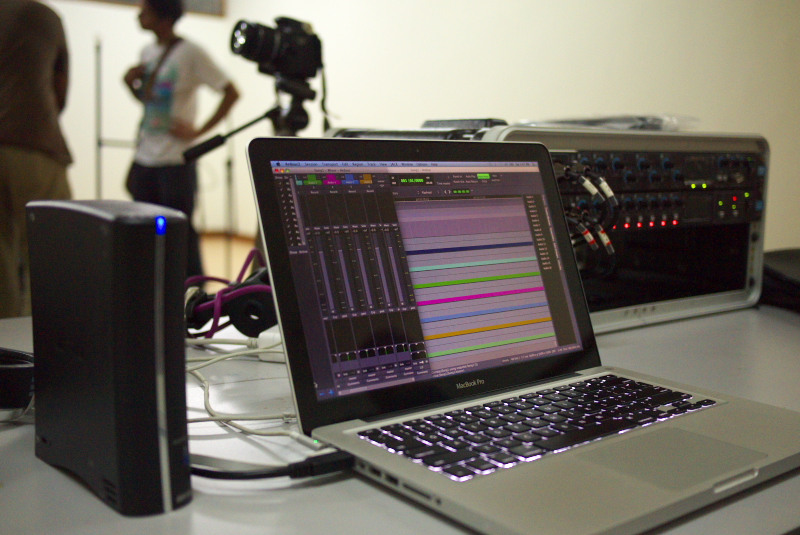Post-production for The Wknd Sessions needs to be done in a logical and easy manner; after all, there are 3 albums' worth of material that we're producing. Things can quickly go south when moving from one step to another when you're dealing with 30 tracks in one go.
First things first: directory structure. After the last couple of seasons, I've adopted the following structure:
- Season X
- Act # X
- Song #1
- Song #2
- Song #3
- Act # Y
:
:
- OUTPUT
- 1-MIXED
- 2-MASTERED
- 3-WAV
- 4-MP3
- 5-MP3-PREVIEW
The Act # X directories will have the audio stems used. The OUTPUT directory will hold all the mixed, mastered, finalized, MP3 and MP3 preview files.
Here's a breakdown of the workflow I'm adopting:
Step 1
Mix, making sure to leave in approximately 10dB of headroom. Lead-in cues are not removed. Files are stored in OUTPUT/1-MIXED directory in 48kHz 16-bit WAV format. Cue lead-ins at the beginning of each song are not removed. No fade-ins or fade-outs.
Step 2
Use files from OUTPUT/1-MIXED and do mastering. Cues lead-ins are not removed. No fade-in or fade-outs are created, but apply silence in between cue and start of the song. Files are stored in OUTPUT/2-MASTERED directory in 48kHz 16-bit WAV format. Use this for the videos.
Step 3
Use files from OUTPUT/2-MASTERED. Remove cues, create the fade-ins and fade-outs where necessary. Files are stored in OUTPUT/3-WAV directory in 44.1kHz 16-bit format. Use this for The Wknd Sessions compilation CD audio.
Step 4
Take files from OUTPUT/3-WAV and convert to MP3 format. ID3 tags are embedded. Files are stored in OUTPUT/4-MP3 directory in MP3 format with constant bit rate @ 192kbps. Use this for The Wknd online store.
Step 5
Take files from OUTPUT/4-MP3 and create 30-second excerpts. 5-second fade-in and fade-out is created for each song. Resulting 30-second clip is saved in MP3 format with constant bit rate @ 192 kbps and stored here. Verify that ID3 tags are still persistent after the file save process. Files are stored in OUTPUT/5-MP3-PREVIEW directory in MP3 format with constant bit rate @ 192kbps. Use this for The Wknd online store previews.
First things first: directory structure. After the last couple of seasons, I've adopted the following structure:
- Season X
- Act # X
- Song #1
- Song #2
- Song #3
- Act # Y
:
:
- OUTPUT
- 1-MIXED
- 2-MASTERED
- 3-WAV
- 4-MP3
- 5-MP3-PREVIEW
The Act # X directories will have the audio stems used. The OUTPUT directory will hold all the mixed, mastered, finalized, MP3 and MP3 preview files.
Here's a breakdown of the workflow I'm adopting:
Step 1
Mix, making sure to leave in approximately 10dB of headroom. Lead-in cues are not removed. Files are stored in OUTPUT/1-MIXED directory in 48kHz 16-bit WAV format. Cue lead-ins at the beginning of each song are not removed. No fade-ins or fade-outs.
Step 2
Use files from OUTPUT/1-MIXED and do mastering. Cues lead-ins are not removed. No fade-in or fade-outs are created, but apply silence in between cue and start of the song. Files are stored in OUTPUT/2-MASTERED directory in 48kHz 16-bit WAV format. Use this for the videos.
Step 3
Use files from OUTPUT/2-MASTERED. Remove cues, create the fade-ins and fade-outs where necessary. Files are stored in OUTPUT/3-WAV directory in 44.1kHz 16-bit format. Use this for The Wknd Sessions compilation CD audio.
Step 4
Take files from OUTPUT/3-WAV and convert to MP3 format. ID3 tags are embedded. Files are stored in OUTPUT/4-MP3 directory in MP3 format with constant bit rate @ 192kbps. Use this for The Wknd online store.
Step 5
Take files from OUTPUT/4-MP3 and create 30-second excerpts. 5-second fade-in and fade-out is created for each song. Resulting 30-second clip is saved in MP3 format with constant bit rate @ 192 kbps and stored here. Verify that ID3 tags are still persistent after the file save process. Files are stored in OUTPUT/5-MP3-PREVIEW directory in MP3 format with constant bit rate @ 192kbps. Use this for The Wknd online store previews.

 RSS Feed
RSS Feed
